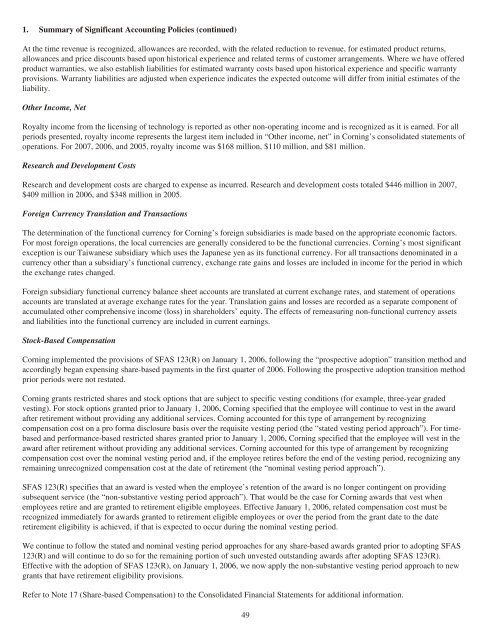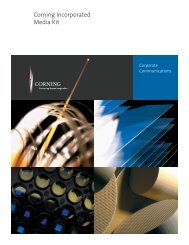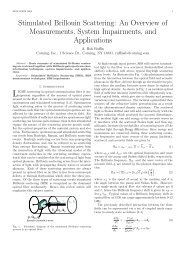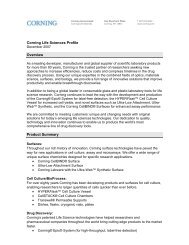Create successful ePaper yourself
Turn your PDF publications into a flip-book with our unique Google optimized e-Paper software.
1. Summary of Significant Accounting Policies (continued)<br />
At the time revenue is recognized, allowances are recorded, with the related reduction to revenue, for estimated product returns,<br />
allowances and price discounts based upon historical experience and related terms of customer arrangements. Where we have offered<br />
product warranties, we also establish liabilities for estimated warranty costs based upon historical experience and specific warranty<br />
provisions. Warranty liabilities are adjusted when experience indicates the expected outcome will differ from initial estimates of the<br />
liability.<br />
Other Income, Net<br />
Royalty income from the licensing of technology is reported as other non-operating income and is recognized as it is earned. For all<br />
periods presented, royalty income represents the largest item included in “Other income, net” in <strong>Corning</strong>’s consolidated statements of<br />
operations. For <strong>2007</strong>, 2006, and 2005, royalty income was $168 million, $110 million, and $81 million.<br />
Research and Development Costs<br />
Research and development costs are charged to expense as incurred. Research and development costs totaled $446 million in <strong>2007</strong>,<br />
$409 million in 2006, and $348 million in 2005.<br />
Foreign Currency Translation and Transactions<br />
The determination of the functional currency for <strong>Corning</strong>’s foreign subsidiaries is made based on the appropriate economic factors.<br />
For most foreign operations, the local currencies are generally considered to be the functional currencies. <strong>Corning</strong>’s most significant<br />
exception is our Taiwanese subsidiary which uses the Japanese yen as its functional currency. For all transactions denominated in a<br />
currency other than a subsidiary’s functional currency, exchange rate gains and losses are included in income for the period in which<br />
the exchange rates changed.<br />
Foreign subsidiary functional currency balance sheet accounts are translated at current exchange rates, and statement of operations<br />
accounts are translated at average exchange rates for the year. Translation gains and losses are recorded as a separate component of<br />
accumulated other comprehensive income (loss) in shareholders’ equity. The effects of remeasuring non-functional currency assets<br />
and liabilities into the functional currency are included in current earnings.<br />
Stock-Based Compensation<br />
<strong>Corning</strong> implemented the provisions of SFAS 123(R) on January 1, 2006, following the “prospective adoption” transition method and<br />
accordingly began expensing share-based payments in the first quarter of 2006. Following the prospective adoption transition method<br />
prior periods were not restated.<br />
<strong>Corning</strong> grants restricted shares and stock options that are subject to specific vesting conditions (for example, three-year graded<br />
vesting). For stock options granted prior to January 1, 2006, <strong>Corning</strong> specified that the employee will continue to vest in the award<br />
after retirement without providing any additional services. <strong>Corning</strong> accounted for this type of arrangement by recognizing<br />
compensation cost on a pro forma disclosure basis over the requisite vesting period (the “stated vesting period approach”). For timebased<br />
and performance-based restricted shares granted prior to January 1, 2006, <strong>Corning</strong> specified that the employee will vest in the<br />
award after retirement without providing any additional services. <strong>Corning</strong> accounted for this type of arrangement by recognizing<br />
compensation cost over the nominal vesting period and, if the employee retires before the end of the vesting period, recognizing any<br />
remaining unrecognized compensation cost at the date of retirement (the “nominal vesting period approach”).<br />
SFAS 123(R) specifies that an award is vested when the employee’s retention of the award is no longer contingent on providing<br />
subsequent service (the “non-substantive vesting period approach”). That would be the case for <strong>Corning</strong> awards that vest when<br />
employees retire and are granted to retirement eligible employees. Effective January 1, 2006, related compensation cost must be<br />
recognized immediately for awards granted to retirement eligible employees or over the period from the grant date to the date<br />
retirement eligibility is achieved, if that is expected to occur during the nominal vesting period.<br />
We continue to follow the stated and nominal vesting period approaches for any share-based awards granted prior to adopting SFAS<br />
123(R) and will continue to do so for the remaining portion of such unvested outstanding awards after adopting SFAS 123(R).<br />
Effective with the adoption of SFAS 123(R), on January 1, 2006, we now apply the non-substantive vesting period approach to new<br />
grants that have retirement eligibility provisions.<br />
Refer to Note 17 (Share-based Compensation) to the Consolidated Financial Statements for additional information.<br />
49







